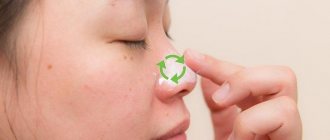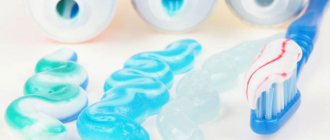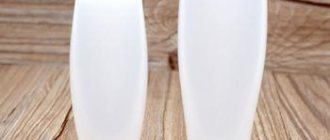17.03.2018
What kind of TOOTHPASTE can you “eat” and in what cases is it better to consult a doctor!
“Most toothpaste is made up of fluoride, a fine abrasive, and a foaming agent. Often parents are AFRAID of taking toothpaste for children with fluoride and take it without it at all. In order to clean your teeth well, you need to take a paste with a fluoride concentration starting with a dosage of 500 ppm. It is important for your child to choose children’s toothpaste according to his age! Fluoride helps prevent tooth decay by maintaining strong tooth enamel and inhibiting the growth of bacteria in plaque. There is no need to be afraid of fluoride itself!” - says pediatric dentist, member of the Association of Preventive and Pediatric Dentistry Yousefian Ehsan. (Shortcut?) To protect children from the dangers of fluoride in toothpaste, parents should treat toothpaste like any other harmful chemical and keep it locked up when not in use. Doctors recommend supervising children under 6 years of age when brushing their teeth and reminding them to spit out the toothpaste rather than swallow it. Parents should also teach children to use toothpaste no larger than a pea-sized amount. Infants younger than 6 months should never be exposed to fluoride toothpaste.
How to use it correctly?
Instructions for use read as follows:
- Take a toothbrush; it is advisable to give preference to soft or medium-hard bristles. You need to moisten it a little in warm water.
- A small amount of powder must be brought to a mushy state. Pour the powder into a separate container and add a couple of drops of water.
- Dip the brush into the resulting mixture.
- Brush your teeth as usual.
You should also consider some useful tips from dentists:
- Do not try to brush your teeth with dry powder; it must be moistened with water.
- It is best to alternate tooth powder with gel paste.
- It is not recommended to use it if you have sensitive enamel.
What to do if a child ate adult pasta
Adult products contain fluoride. They are dangerous when ingested in large quantities into the gastrointestinal tract. Cause the following negative reactions:
- intoxication with increased body temperature;
- irritation and inflammation of the mucous membrane;
- profuse diarrhea with risk of dehydration.
Parents should give the child a sorbent by immediately going to the hospital. If the doctor sees toxins in the composition, he will prescribe gastric lavage. Additionally, therapy is carried out to replenish the lack of fluid caused by diarrhea. Parents should not give other medications themselves.
Note! The pediatrician will recommend staying in the hospital for 1-2 days after swallowing the substance to eliminate the risk of adverse reactions. If they appear, additional therapy is prescribed.
Swallowing toothpaste in small quantities does not lead to disruption of body functions. But if a child or adult has swallowed a large amount of the product, consult a doctor. The paste can cause serious harm to the gastrointestinal tract. To eliminate the risk for young children, consult a dentist to choose a product that contains only natural ingredients.
Myths about tooth powder
The main myth is that it causes enormous harm to teeth. In fact, if the teeth are in healthy condition and if all the rules are followed, then harm is practically excluded. Negative changes can only occur if you use the powder on an ongoing basis.
Another common misconception is poor quality plaque cleansing. In fact, according to statistics, this product copes with this task even better than the most expensive toothpaste from a well-known manufacturer.
Dangerous additives
Saccharin is a non-hazardous substance that helps manufacturers make the taste of pasta more pleasant and soft. However, sugar can also negatively affect the condition of the oral cavity, because, as is known, sweets provoke the development of bacteria and can lead to the gradual destruction of hard tissues.
Glycerin is a necessary additive that prevents toothpaste from quickly hardening and drying out even when opened. Unfortunately, the substance can cause digestive problems. Another component is paraffin. It is necessary to achieve the thickness and viscosity of the product. Large amounts of this substance in the body can lead to severe vomiting or constipation.
Is menthol included in toothpastes dangerous? Unfortunately, yes, it can negatively affect the functioning of the human heart and blood vessels, while it freshens breath very well. Formaldehyde is necessary to resist dangerous microbes, however, frequent use of pastes containing it, and especially their entry into the body when swallowed, can lead to vision problems and the development of pathological processes in the liver and kidneys.
How to take care of your teeth while wearing braces
Table of contents
- Hygiene products
- Dental care while wearing braces: proper nutrition
- Hygiene after eating
- Can I use an electric toothbrush?
- Can I use dental floss?
- Advantages of contacting MEDSI
Proper oral hygiene is not an easy task. Not everyone can provide it. It is not surprising that the situation gets worse while wearing braces. During this period, hygiene should be given especially close attention. How to do it? Let's figure it out and determine what kind of dental care with braces is necessary, and how to properly provide it.
Hygiene products
Toothbrushes
It is better to buy these hygiene products with a V-shaped recess. These brushes are specially designed for oral care with braces. They allow you to thoroughly clean the teeth on which the braces are attached. You can also choose mono-bundle products for yourself. They will allow you to thoroughly clean all hard-to-reach places and the orthodontic structures themselves. When choosing a brush, always rely not only on your dentist’s recommendations, but also on your own feelings.
Toothpastes
People who wear braces often complain that their teeth have become more sensitive to various external influences. This is due to the pressure exerted. Therefore, you should always use toothpaste for sensitive teeth. Additionally, it is advisable to purchase an anti-plaque product. It is better to change the paste every 3-4 months. When selecting it, also be guided by the dentist’s recommendations and your own feelings.
Cleaners
These products are very convenient to use after every meal. Moreover, dental hygiene with braces can be carried out not only at home, but also at work, in a cafe or restaurant. Usually food particles remain under the arch and on the tops of the plates. Brushes easily clean hard-to-reach areas. These products are effective in removing food debris and between teeth.
Important! You should carefully consider such a parameter of brushes as their thickness. You should be comfortable using the product. If using a brush causes discomfort, try replacing it with a thinner one.
Irrigator
With its help, you can always thoroughly clean the spaces between teeth and other hard-to-reach areas.
Rinse aid
If you have been using a certain product for many years and it suits you, replacement is not necessary.
Protective wax
Caring for teeth with braces involves not only cleaning them, but also maintaining health and maintaining daily comfort. Special wax helps prevent the arches and protruding edges of the structure from rubbing the inner surfaces of the cheeks. A special remedy will avoid not only tissue injury, but also the development of inflammatory processes.
Important! It should be understood that dental hygiene with braces should be carried out not only when you are at home, but also on the road, traveling and business trips. Therefore, we advise you to order or assemble a so-called travel kit yourself. It will be the ideal companion for all people leading an active lifestyle. It is more convenient to assemble it from products that are sold in mini format.
Dental care while wearing braces: proper nutrition
After installing an orthodontic structure, 3 basic principles must be observed:
- Avoid sticky and very hard foods. It is recommended to exclude toffees and chewing gum, seeds and nuts, chips, waffles, chocolate, etc. from the diet. They can accumulate on the braces themselves and under the arches. Cleaning up the leftovers will be quite difficult.
- Avoiding hard fruits and vegetables. You can eat them, but first cut them into small pieces. Chew hard vegetables and fruits exclusively with your lateral teeth.
- Avoiding too hot food and drinks. Their use may cause the records to peel off.
The rest of the diet can remain unchanged. There is no need to abuse soft and liquid food for fear of spoiling or breaking the structure. Teeth must constantly receive sufficient load. At the same time, it is important to be prepared for the fact that at first, eating some foods and dishes made from them may cause discomfort. The degree of intensity of discomfort usually varies from mild and insignificant to severe. If you find it difficult to eat in the first few days after installing the structure, give preference to broths and soups, cereals, and dairy products. For some time, even meat, poultry and fish can be simply blended with a blender. This will allow you to bring them to the consistency of puree without changing the usual tastes.
Important! If eating becomes impossible due to severe discomfort, you should consult a doctor.
Hygiene after eating
It is this dental care with braces that you should pay special attention to. Even if the meal was insignificant, you should not just brush your teeth, but also use a brush and mouthwash.
Important! Hygiene should be carried out in front of a mirror and in good lighting. This way you can detect any leftover food and remove it. This will allow you to maintain the snow-white shade of the enamel and the health of your teeth after removing the braces.
Particular attention is paid to cleaning.
If you have a special brush, all movements should be made horizontally, along the line of the braces arc. If you use a standard brush, vertical and horizontal movements are made. In this case, each plate should be cleaned separately. After basic cleaning, use brushes or a single-tuft brush. They will allow you to clean all the spaces between the teeth and their surfaces, as well as the plates. Don't forget about cleaning the brackets located on the far teeth. Usually a large amount of plaque accumulates on them.
The cleaning process should take at least 3 minutes. You should rinse your mouth for another 1-2 minutes.
If you have a waterpik, don't neglect it. You can also direct a stream of water at the plates. In this case, it is advisable to reduce the pressure.
Can I use an electric toothbrush?
Yes!
When choosing such a maintenance tool, give preference to those models that have a fixed head and do not provide strong vibration. You will not damage the bracket system, but using such products is not very convenient.
But it’s better not to use an ultrasonic brush. This is due to the fact that it can lead to the plates coming off.
Can I use dental floss?
Yes!
It will allow you to efficiently remove all contaminants from the interdental spaces. Movements must be vertical. In this case, the thread must be inserted under the arc.
Important! When using floss, you need to be careful not to damage the elements of the orthodontic structure.
Advantages of contacting MEDSI
- High-tech dentistry.
Our clinics provide complex therapy. Thanks to this, each patient receives a full range of services: from preparation for installing braces to monitoring their wearing and oral care by the dentist. It is also important that we are ready to offer modern designs for therapy, characterized by maximum comfort and efficiency. - High competence of specialists.
Our doctors have all the necessary knowledge and skills to install braces and ensure maximum effectiveness of orthodontic therapy - Treatment without pain and discomfort.
All stages of therapy are carried out without discomfort - Comfort of visiting the clinic. We made sure there were no queues. Our patients visit the doctor on time and do not waste time waiting
To clarify the conditions of orthodontic treatment and make an appointment, just call +7 (495) 7-800-500. Our specialist will answer all questions. Recording is also possible through the SmartMed application.
How often should you go to the dentist?
Most people know what perfume, nail polish, mascara, etc. suits them. In the same way, we should know what suits our mouth. To do this, you need to find a dentist you trust. It is equally important that the dentist has been supervising you for many years, knows what fillings were placed on you and when, how often you need to carry out professional hygiene around the implants, etc. Having a permanent dentist is just as necessary as having a family member in your life doctor, pediatrician. The dentist will help you find out where you are not brushing your teeth well and where a lot of mature plaque accumulates. And he will recommend methods and means of oral hygiene that are suitable for you. Today, tooth coatings have been developed containing nanohydroxyapatite and fluorides (fluoride varnish), which protect against caries. But all these remedies are effective provided that the patient follows the rules of hygiene. Don’t think that if you don’t have time or don’t feel like brushing your teeth properly, you can go to the dentist once every six months for a professional cleaning, and all problems will be solved. Plaque, which forms on the teeth due to the presence of food debris and microorganisms in the oral cavity, must be treated at least once every 24 hours. Otherwise, it acquires harmful properties and can cause caries and inflammatory periodontal diseases. Therefore, it is necessary to visit the dentist once every six months. And you need to brush your teeth well every day - this will help preserve both your health and a lot of money.
About fluoride
To prevent the development of caries, it is best to use pastes with fluoride in organic form. That is, it is important that the composition contains olafur or, alternatively, amino fluoride. There is less fluoride in children's toothpastes than in analogues for adults. For example, in products from SPLAT Junior this is the fluorine content: in fluoridated foam there is 0.01% of this element, and in pastes for children 3-8 years old it is only 0.05%. The paste can provide the teeth with fluoride and calcium, at best, by 30%.
We have not listed all the problems caused by toothpastes that include inexpensive, recently popular, but no less dangerous components. And therefore, the important, necessary and useful habit of reading is becoming increasingly widespread among parents, from which, in fact, hygiene products for their children are made. That is why those pastes that cause allergies, undermine health, or pose other dangers for the child so quickly lose popularity.
Question No. 6. Is it possible to whiten teeth with toothpaste in a few days?
No. No toothpaste will make your teeth perfectly white. Unscrupulous manufacturers attract the attention of consumers with sophisticated advertising campaigns, and for greater “effect” they add coarse abrasives or peroxides to their products, which not only remove plaque from teeth, but also harm the enamel.
If the desire to have a snow-white smile is very great, you can get closer to your cherished goal! Professional teeth cleaning and whitening in a dental setting will help achieve the desired result.”
Toothpastes with fluoride salts help solve many dental problems.
Prevention of caries. Fluoride, entering the enamel structure, treats caries at the spot stage and helps to avoid the formation of new carious lesions.
Protection against demineralization. The combination of fluorides with hydroxyapatite (the main structural element of tooth enamel) forms fluorapatite, which is more resistant to acids produced by pathogenic microorganisms. Thanks to this, the processes of enamel demineralization stop. Moreover, fluorides accelerate the process of reminarilation (enrichment of enamel with calcium and phosphorus), which significantly reduces the risk of developing caries.
Protection against lactic acid. Fluoride prevents the production of lactic acid, which means it significantly reduces the growth of pathogenic microorganisms and additionally protects the enamel.











